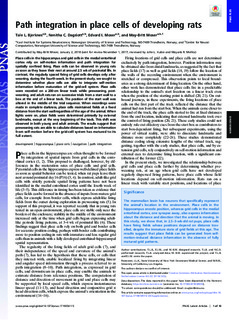| dc.contributor.author | Bjerknes, Tale Litlere | |
| dc.contributor.author | Dagslott, Nenitha | |
| dc.contributor.author | Moser, Edvard Ingjald | |
| dc.contributor.author | Moser, May-Britt | |
| dc.date.accessioned | 2018-02-28T14:32:03Z | |
| dc.date.available | 2018-02-28T14:32:03Z | |
| dc.date.created | 2018-02-08T10:12:47Z | |
| dc.date.issued | 2018 | |
| dc.identifier.issn | 0027-8424 | |
| dc.identifier.uri | http://hdl.handle.net/11250/2487828 | |
| dc.description.abstract | Place cells in the hippocampus and grid cells in the medial entorhinal cortex rely on self-motion information and path integration for spatially confined firing. Place cells can be observed in young rats as soon as they leave their nest at around 2.5 wk of postnatal life. In contrast, the regularly spaced firing of grid cells develops only after weaning, during the fourth week. In the present study, we sought to determine whether place cells are able to integrate self-motion information before maturation of the grid-cell system. Place cells were recorded on a 200-cm linear track while preweaning, postweaning, and adult rats ran on successive trials from a start wall to a box at the end of a linear track. The position of the start wall was altered in the middle of the trial sequence. When recordings were made in complete darkness, place cells maintained fields at a fixed distance from the start wall regardless of the age of the animal. When lights were on, place fields were determined primarily by external landmarks, except at the very beginning of the track. This shift was observed in both young and adult animals. The results suggest that preweaning rats are able to calculate distances based on information from self-motion before the grid-cell system has matured to its full extent. | nb_NO |
| dc.language.iso | eng | nb_NO |
| dc.publisher | National Academy of Sciences | nb_NO |
| dc.rights | Attribution-NonCommercial-NoDerivatives 4.0 Internasjonal | * |
| dc.rights.uri | http://creativecommons.org/licenses/by-nc-nd/4.0/deed.no | * |
| dc.title | Path integration in place cells of developing rats | nb_NO |
| dc.type | Journal article | nb_NO |
| dc.type | Peer reviewed | nb_NO |
| dc.description.version | publishedVersion | nb_NO |
| dc.source.journal | Proceedings of the National Academy of Sciences of the United States of America | nb_NO |
| dc.identifier.doi | 10.1073/pnas.1719054115 | |
| dc.identifier.cristin | 1563092 | |
| dc.description.localcode | Copyright © 2018 the Author(s). Published by PNAS. This open access article is distributed under Creative Commons Attribution-NonCommercial-NoDerivatives License 4.0 (CC BY-NC-ND). | nb_NO |
| cristin.unitcode | 194,65,60,0 | |
| cristin.unitname | Kavliinstitutt for nevrovitenskap | |
| cristin.ispublished | true | |
| cristin.fulltext | postprint | |
| cristin.qualitycode | 2 | |

